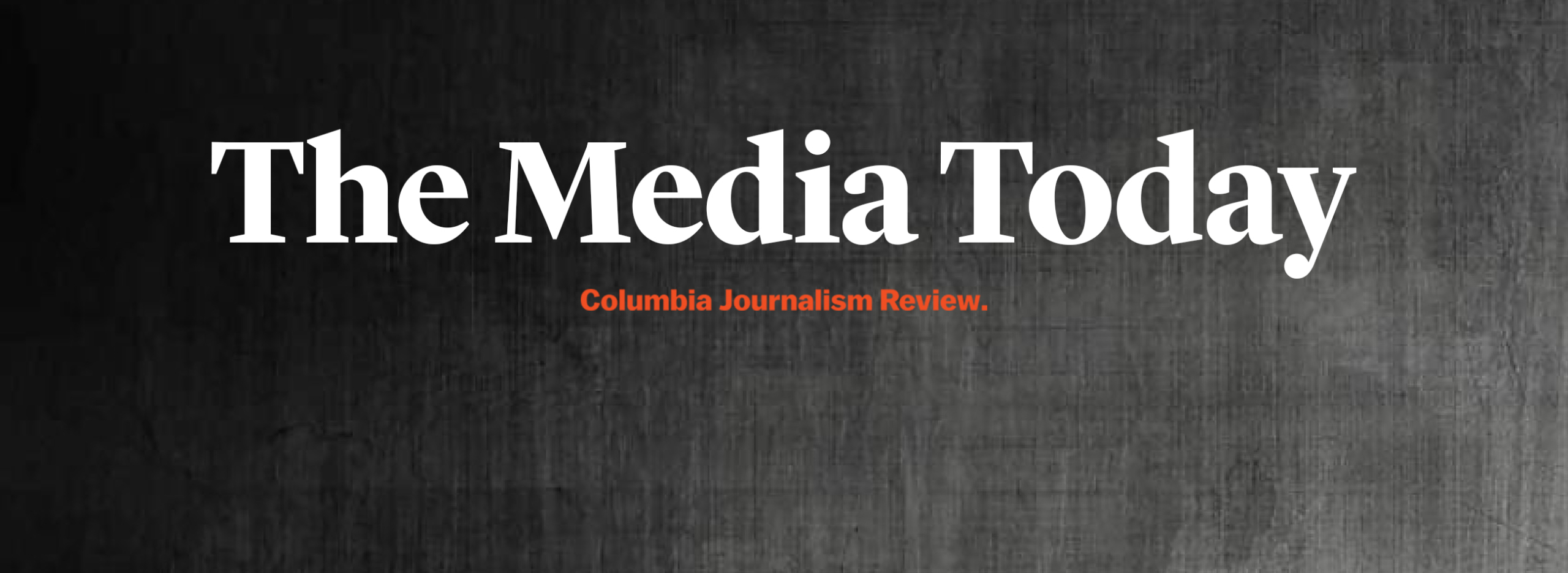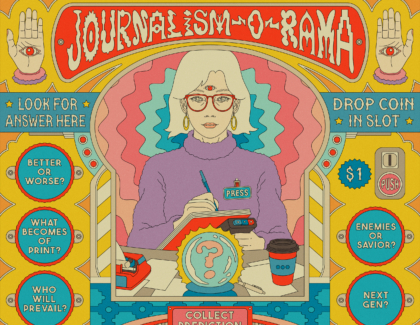Sign up for the daily CJR newsletter.
On Wednesday, the sky over the Bay Area turned orange. The visual was alien, yet the cause—rampant wildfires, accelerated by climate change—was very much a this-world problem. “Some folks said it felt like living on the next planet over, the red one,” Steve Rubenstein and Michael Cabanatuan wrote on the front page of yesterday’s San Francisco Chronicle. “Others said it was like a solar eclipse, but longer, or the apocalypse, but less biblical.” Their story appeared under a banner headline, “SURREAL SKY, SURREAL YEAR.” A photo, spanning the width of A1, showed a passerby, clad in shorts, sneakers, and a medical mask, staring upward; behind him, the lights that typically illuminate the Bay Bridge at night were still glowing, because their sensors had been unable to detect the sunrise. Catherine Geeslin, a Bay Area resident, told the Chronicle, “It feels like the end of the world, or like Mordor.”
The fires are not only in California—swaths of land are ablaze along the length of the West Coast. The flames have torched entire towns and killed at least fifteen people, seven of whom were found dead yesterday. In Washington State, more than five hundred thousand acres have burned; in Oregon, the figure is nearly double that. In California, more than three million acres are charred, including a patch of the Mendocino National Forest that now constitutes the biggest fire in the state’s history. Hundreds of thousands of people have had to evacuate their homes. As I wrote recently, that’s a complicated feat in the midst of a pandemic.
ICYMI: How the New York Times editorial page got sued by Sarah Palin
The fires are life-changing, yet the story here is sadly repetitive. Some journalists who live out West have argued that the national press isn’t paying sufficient attention to their plight, particularly compared to the urgency in coverage of hurricanes that hit the East Coast. “I hate being ‘what if national media covered California like they cover New York’ guy,” Kevin Roose, a New York Times tech columnist based in the Bay Area, wrote on Twitter, “but if the sky looked like this in Brooklyn there would already be 142 essays and 17 commissioned TV specials about ‘our orange tomorrow.’ ” Roose’s colleague Charlie Warzel, who lives in Montana, asked, in a column, whether eastern journalists would take fire seasons—and, consequently, climate change—more seriously if they had to experience the flames.
Criticisms like these have irked staffers at outlets—the LA Times, for instance—that are covering the fires aggressively. And they have opened up other complaints: ProPublica’s Jessica Huseman, who lives in Texas, observed that the East and West Coasts both enjoy an ample media presence compared to the middle of the country, where disasters, such as the recent derecho in Iowa, are frequently ignored by the national press. The reality is, of course, that there are national journalists doing strong work in response to the fires, yet the fires story hasn’t inspired a comparable media frenzy to, say, the one circling Bob Woodward’s new book. The problem is one of consistency and prominence.
Which brings us to the importance of making a connection to the climate crisis. During California fire seasons in 2018 and 2019, I observed, in this newsletter, that despite some excellent climate-centered enterprise reporting and editorials, major outlets were generally doing a poor job of integrating climate change into their quick-turn news stories. This year, the picture has been similarly mixed—this morning, the top headline on the Times’ homepage is “A Climate Reckoning in Fire-Stricken California,” yet other national stories, including in the Times, have failed to assert any climate link. In late August, CJR and The Nation’s Covering Climate Now project tracked notable instances of climate-free fires coverage; this week, Emily Atkin, who writes the climate newsletter Heated, pointed to more bad examples. Allison Fisher, of the progressive watchdog group Media Matters for America, reports that between September 5 and 8, ABC, NBC, and CBS collectively ran forty-six segments on the fires. Only seven mentioned climate change; Jeff Berardelli, a CBS meteorologist, contributed four of the seven, and ABC contributed none. PBS did a better job.
As I wrote recently, America is living through a period of compounding crises—from climate disasters to the pandemic to racist violence—whose story lines intersect as they drift along the same currents: death, destruction, despair. On Wednesday, Ed Yong, of The Atlantic, argued that amid all the carnage, we may have become collectively “habituated to horror.” Anne Helen Petersen borrowed that phrasing in Culture Study, her newsletter, which dwelled at greater length on the fires. “People keep comparing the photos of San Francisco against the backdrop of eerie orange to Blade Runner,” she wrote. “It’s a way of deflecting the fear, of making it speakable through comparison to a text that is solidly otherworldly. But the thing about dystopian narratives is that they are not distant from our world; they’re just what happens when our world, or at least our civilization, begins to bend towards its end.” Habituation is dangerous, in journalism as in life.
Below, more on fires:
- Shouting ‘fire’ in a burning building: Another familiar problem with the fires story is that it has, in some parts of the internet, become a conduit for conspiracy theories. The Daily Beast’s Kelly Weill points to the case of an independent journalist who, while filming the fires in Oregon, was accused of arson and received death threats on social media. According to the Times, armed people in the same area threatened other reporters. And HuffPost’s Christopher Mathias notes that Law Enforcement Today, a news site for cops, published an unfounded rumor blaming “Antifa” activists for starting fires.
- Access denied: Janie Har and Felicia Fonseca report, for the Associated Press, that journalists in different states enjoy different rights when it comes to covering fires. A California law “guarantees press virtually unfettered access to disaster sites in evacuated areas that are off-limits to the public,” but reporters in Oregon, Washington, and other states aren’t permitted to explore fire areas without an escort.
- Not only in America: Atkin, of Heated, reminds us that climate change is fueling fires in other countries, too, amid one of the hottest years on record. “A quick scan of Getty Images shows the magnitude of the crisis we’re dealing with,” she writes. “Type in ‘wildfire,’ and you won’t just get photos of The San Francisco Bay Bridge seemingly superimposed in hell. You’ll get photos of Brazil, Greece, Argentina, Indonesia, and Bulgaria, all of which have been dealing with chaotic wildfire over the last month.” Earlier this year, she wrote for CJR, “In order to make an impact on climate journalism, I’ve learned, I need to turn my despair into rage.”
- The climate problem: Last month, amid fires in Colorado, Corey Hutchins, of the Colorado Independent, assessed why some local outlets—especially in rural areas—neglected to make the link to climate change in their coverage. “If we mention it, people literally turn away and won’t listen to anything else we say,” Niki Turner, publisher of the Rio Blanco Herald-Times, said. “It’s a terrible position to be in.”
- The climate issue: This spring, CJR published a magazine dedicated to climate coverage. It included a profile, by Lauren Markham, of Lizzie Johnson, a fire beat reporter at the Chronicle, and an interview with George Miller, the director of Mad Max, who spoke with Kyle Pope, CJR’s editor and publisher, from Sydney, Australia, under a glowing red, smoke-filled sky.
Other notable stories:
- Yesterday, CJR published a map showing how, since the coronavirus pandemic began, governments have harassed, threatened, and detained journalists who have documented its spread. To build the map, a team of CJR interviewers spoke with dozens of reporters and editors worldwide. Tamás Bodoky, the publisher of an independent news site in Hungary, said that it was “scary” when hospitals leaked information to his site, because the government had vowed to punish “fearmongering.” Abdulloh Ghurbati, a journalist in Tajikistan, reported being labeled as a terrorist by government-backed trolls. Some journalists have been frightened into backing off the story: “For now, I’ve turned my attention away from the pandemic—the regime has made it clear that the only figures that can be put out are theirs,” Darvinson Rojas, in Venezuela, said. Still, many others have persisted, in spite of the risk: Mohammad Mosaed, in Iran, was sentenced to four years and nine months in prison. “Anyone who chooses journalism has a responsibility toward society and truth,” he said.
- As expected, yesterday the Republican-controlled Senate failed to pass even a slimmed-down coronavirus stimulus package. I wrote yesterday that the ongoing stimulus failure—amid bleak economic conditions for millions of Americans—should be a bigger story than Bob Woodward’s book. Elsewhere, the Pentagon rescinded an order to shut down Stars and Stripes—a taxpayer-funded, yet editorially-independent, military newspaper—after Trump tweeted that it should continue to operate. On Tuesday, I explored the suspicious timing of Trump’s tweet.
- The Times and the Post both published big projects yesterday. The Times built a gallery showing the faces of 922 of the most powerful people in the US—from police chiefs to members of Trump’s cabinet—and found that only 180 of them are people of color. And the Post investigated the cases of four people federal agents scooped off the streets of Portland, Oregon, during protests this summer. The four people, speaking publicly for the first time, described their ordeals as “harrowing and unnerving.” None of them has subsequently been charged with a crime.
- In local-news news, McClatchy voluntarily recognized a union drive at the Island Packet and the Beaufort Gazette, two of its papers in South Carolina; CNN’s Kerry Flynn has more. Elsewhere, the Windy City Times, an LGBTQ paper in Chicago, is closing its print edition after the pandemic caused advertising revenue to drop; the Windy City Times will now be online-only. And the Minneapolis Star Tribune organized a virtual version of the Minnesota State Fair after the real thing was canceled; Poynter’s Kristen Hare has more.
- For CJR, Bill Grueskin examines what went wrong when, in 2017, the Times, erroneously accused Sarah Palin of inciting the shooting of Congresswoman Gabrielle Giffords. Palin sued for libel; Grueskin reviewed court records in the case, which will go to trial next year. The records, he writes, “reveal systemic problems in the way that Times writers and editors interact, especially when operating under deadline and in distant bureaus.”
- Megyn Kelly is back (again)—she’s launching a self-funded podcasting company called Devil May Care Media, and will host its Megyn Kelly Show. The first episode will appear at the end of the month. “I’ve been controlled by other people for too long,” Kelly told Anne Steele, of the Wall Street Journal. “I don’t think I was meant to have a boss.”
- On Wednesday, the body of Julio Valdivia—a reporter with El Mundo, a local newspaper in Mexico—was found near train tracks in Veracruz state. He had been decapitated. The circumstances of his death remain unclear, but a colleague told the Committee to Protect Journalists that Valdivia had been covering crime in an area scarred by gang violence.
- The New Yorker’s Masha Gessen spoke with Svetlana Alexievich, the Belarusian writer and Nobel laureate who, following a disputed election in the country last month, joined an opposition group that hoped to negotiate with the regime. The entire group has since been jailed or exiled—apart from Alexievich. “I’m going to be here to the end,” she vows.
- And today marks the 19th anniversary of 9/11. Writing in The Atlantic, Garrett M. Graff, the author of an oral history of 9/11, asks why the collective grief that defined the aftermath has been missing during the pandemic. One reason, he writes, is that the virus has “created a different sensory experience,” that “is difficult to capture on TV.”
ICYMI: Journalism’s Gates keepers
Has America ever needed a media defender more than now? Help us by joining CJR today.







